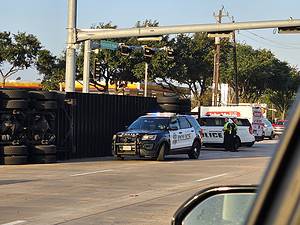
Truck accidents are a road hazard for all drivers. Truck accident statistics demonstrate the extent of the danger.
Table of Contents
Key Takeaways
- Truck accidents are a major concern for all drivers.
- The truck accident statistics help companies and communities develop preventative measures
- Truck accident statistics can provide insights into the frequency, severity, and causes of truck accidents.
- Understanding truck accident statistics is vital in implementing preventive measures.
- Technological advancements, driver education programs, and regulatory changes are among the preventive measures that can be implemented to mitigate the risk of truck accidents.
Truck Accident Statistics
Truck accident data is compiled from various sources using different methods to provide a comprehensive overview of these incidents. Understanding how this data is collected and analyzed is crucial to making informed decisions regarding road safety.
Large truck accidents are reported to the Federal Motor Carrier Safety Administration (FMCSA) by state authorities, enforcement agencies, and the trucking companies involved. The FMCSA then compiles this data into the Motor Carrier Management Information System (MCMIS), which is used to identify trends and patterns in truck accidents.
Additionally, private organizations such as the National Highway Traffic Safety Administration (NHTSA) and the Insurance Institute for Highway Safety (IIHS) collect and analyze truck accident data to provide a broader perspective on road safety.
It is important to note that the accuracy of truck accident data depends on the reporting and classification methods used. For example, minor accidents may not be reported, while different states may classify the same type of accident differently.
To gain a better understanding of truck accident data, we must analyze it in conjunction with other factors, such as road conditions, weather, and vehicle specifications. By doing so, we can develop a more complete picture of the factors that contribute to truck accidents and improve road safety for all.
Frequency of Truck Accidents
Truck accidents are a serious concern due to their frequency and potential for severe consequences. According to the National Highway Traffic Safety Administration (NHTSA), there were over 4,000 fatalities involving large trucks in 2019. This equates to approximately 11 deaths per day, highlighting the severity of the issue.
The number of truck accidents has been gradually increasing in recent years. The Federal Motor Carrier Safety Administration (FMCSA) reported 148,000 large truck crashes in 2019, up from 107,000 in 2010. This represents a 38% increase in just under a decade.
| Year | Number of Large Truck Crashes |
|---|---|
| 2010 | 107,000 |
| 2011 | 104,000 |
| 2012 | 107,000 |
| 2013 | 110,000 |
| 2014 | 117,000 |
| 2015 | 119,000 |
| 2016 | 119,000 |
| 2017 | 121,000 |
| 2018 | 145,000 |
| 2019 | 148,000 |
The majority of truck accidents occur on weekdays and during daylight hours when there are more vehicles on the road. The FMCSA reports that Monday through Friday accounted for 78% of all large truck crashes in 2019.
Furthermore, truck accidents can be particularly dangerous on highways and interstates, where high speeds and heavy traffic can exacerbate the impact of a collision. The FMCSA reported that 55% of all fatal crashes involving large trucks in 2019 occurred on major roads other than interstates, while 30% occurred on interstates.
Causes of Truck Accidents
Truck accidents often result in severe injuries and fatalities, making it essential to understand the causes behind them. By identifying the root causes, we can work towards preventing future accidents and ensuring safer roads for everyone. Several factors can contribute to truck accidents, including:
- Driver Error: The most common cause of truck accidents is driver error, which accounts for approximately 55% of all incidents. Distracted driving, fatigue, and speeding are some of the main reasons behind driver error.
- Mechanical Failures: Trucking companies have a responsibility to ensure that their vehicles are well-maintained to prevent mechanical failures. These can include brake failure, tire blowouts, and steering malfunctions.
- External Factors: Road conditions, weather, and traffic can all impact the likelihood of a truck accident occurring. For example, poor road conditions can increase the risk of a tire blowout or loss of control.
- Cargo Shifts: Trucks carrying loads that are improperly secured or overloaded can lead to cargo shifts, causing the driver to lose control of the vehicle.
- Blind Zones: Trucks have significant blind spots, making it challenging for drivers to see other vehicles on the road. This can result in collisions when drivers change lanes or turn.
Understanding these causes is crucial for developing preventive measures to reduce the number of truck accidents on our roads. Trucking companies can implement stricter safety regulations, conduct regular vehicle inspections, and invest in new technologies to improve road safety. Similarly, drivers can undergo training programs to ensure they are aware of the risks associated with driving a large truck and the importance of driving safely.
According to the Federal Motor Carrier Safety Administration (FMCSA), failure to maintain brakes was the most common vehicle-related factor in fatal large truck crashes.
Additionally, regulatory changes, such as mandating the use of electronic logging devices to track driver hours, can help prevent accidents caused by driver fatigue. By addressing the root causes of truck accidents, we can work together to create safer roads for all users.
Factors Influencing Truck Accident Severity
The severity of a truck accident can be influenced by various factors. By analyzing these factors, we can gain insights into the potential outcomes of different accident scenarios, and work towards promoting road safety. Here are some of the critical factors that influence truck accident severity:
Vehicle Size and Weight
One of the most significant factors that influence truck accident severity is the size and weight of the vehicle. Commercial trucks are much larger and heavier than passenger cars, so collisions involving them are typically more severe. According to the National Highway Traffic Safety Administration, 72% of people killed in large truck crashes in 2019 were occupants of other vehicles.
Speed of Impact
The speed of impact can also significantly affect the severity of a truck accident. When a truck collides with another vehicle or object at high speed, the force of the impact increases, leading to more severe damage and injuries. Additionally, high-speed collisions can increase the risk of the truck rolling over, causing even more damage.
Angle of Impact
The angle of impact can also play a role in determining the severity of a truck accident. Head-on collisions, for example, are typically more severe than rear-end collisions. The angle of impact can also affect the risk of the truck rolling over, which can significantly increase the risk of damage and injuries.
Weather Conditions
Weather conditions can also play a role in determining the severity of a truck accident. Wet or icy roads can make it more challenging for the truck driver to control their vehicle, increasing the risk of a collision. Additionally, poor visibility due to fog or heavy rain can increase the risk of accidents.
By understanding these factors, we can work towards implementing preventive measures that address these issues. For example, strict speed limits and weight restrictions for trucks can help reduce the severity of accidents. Additionally, promoting safe driving practices and providing driver education programs can help reduce the risk of collisions caused by driver error. Ultimately, by prioritizing road safety, we can work towards a future with fewer severe truck accidents.
Impact of Truck Accidents on Road Safety
Truck accidents have a significant impact on road safety, affecting not only the drivers involved but also other motorists, pedestrians, and the community at large. In this section, we will delve into the broader implications of truck accidents on road safety and how they can affect us all.
“Truck crashes can cause devastating consequences, including serious injuries and fatalities. These accidents can also have a significant economic impact on communities.”
Truck accidents can result in severe injuries and even fatalities, which can have long-lasting effects on victims and their families. According to the National Highway Traffic Safety Administration (NHTSA), over 5,000 people died in crashes involving large trucks in 2019 alone. The NHTSA also reports that approximately 118,000 people were injured in truck accidents during the same year.
Truck accidents can also have a significant economic impact on communities. Property damage, medical expenses, and lost wages can all have a ripple effect, affecting businesses, individuals, and local economies. Additionally, truck accidents can cause road closures and traffic congestion, further disrupting daily life and imposing financial burdens.
The Ripple Effect of Truck Accidents
Truck accidents can have far-reaching consequences, not just for those involved but also for the larger community. Here are some of the ways truck accidents can impact road safety:
| Impact | Consequence |
|---|---|
| Injuries and fatalities | Long-lasting physical and emotional trauma for victims and their families. |
| Property damage | Costly repairs and replacement for damaged vehicles, infrastructure, and other property. |
| Financial burden | Medical expenses, lost wages, and other unforeseen costs can create financial challenges for individuals and businesses. |
| Traffic congestion | Disruptions to daily life and the flow of traffic can cause delays, leading to frustration and impatience among drivers. |
| Effects on the environment | Truck accidents can cause spills and other environmental hazards, impacting air and water quality and potentially harming wildlife. |
It is imperative to understand the ripple effect of truck accidents to fully appreciate the importance of road safety. Preventive measures must be taken to reduce the frequency and severity of truck accidents, improving safety for all road users.
- Driver education programs can help increase awareness and identify potential hazards.
- Technological advancements, such as collision avoidance systems, can help prevent accidents before they occur.
- Regulatory changes, such as strict enforcement of hours-of-service regulations and mandatory rest breaks, can reduce the incidence of driver fatigue and increase alertness behind the wheel.
By prioritizing proactive measures and awareness, we can increase road safety for all and reduce the number of truck accidents on our roads.
Preventive Measures to Reduce Truck Accidents
Truck accidents can often be prevented through a combination of safety measures and proper training. By addressing the root causes of accidents and taking proactive steps to mitigate risks, we can work towards reducing the number of accidents on our roads. Below are some preventive measures that can help reduce the occurrence of truck accidents.
1. Technological Advancements
New technologies, such as automatic braking systems and lane departure warnings, can help prevent accidents caused by driver error. These safety features can detect potential hazards and alert drivers, giving them time to react and avoid a collision. In addition, telematics systems that monitor driving behavior can help identify risky driving habits and provide feedback for improvement.
2. Driver Education and Training Programs
Proper training and education programs are crucial for ensuring that truck drivers have the necessary skills to operate their vehicles safely. This includes training on defensive driving techniques, load securement, and other safety protocols. Ongoing training can also help reinforce good habits and identify areas where drivers may need additional support.
3. Regulatory Changes
Regulatory changes can also play a role in reducing truck accidents. For example, stricter hours-of-service regulations can help reduce driver fatigue, which is a common cause of accidents. Improved vehicle maintenance requirements can also help ensure that trucks are in good condition and less likely to experience mechanical failures while on the road.
4. Safety Culture
A culture of safety is essential for preventing truck accidents. Companies must prioritize safety and encourage their drivers to do the same. This can be achieved through regular safety meetings, incentivizing safe driving behavior, and rewarding drivers for achieving safety milestones. In addition, companies can create a reporting system that encourages drivers to report safety concerns without fear of reprisal.
5. Collaboration and Communication
Collaboration and communication between all stakeholders involved in the trucking industry can help promote safety and prevent accidents. This includes sharing data on accident rates, identifying areas for improvement, and working together to implement effective solutions. By working together, we can create a safer environment for all road users.
Legal Considerations in Truck Accident Cases
Truck accidents can have severe legal and financial consequences for all parties involved, making it crucial to understand the legal considerations in such cases. Liability is a key factor in any truck accident case, and it typically falls on the driver, trucking company, or other involved parties. Insurance coverage can provide a safeguard against liability, but it’s essential to ensure sufficient coverage.
During a truck accident, evidence can be crucial in determining liability and pursuing legal action. This evidence can include police reports, eyewitness accounts, and data from the truck’s onboard recording devices. It’s essential to gather and preserve evidence as soon as possible after an accident to strengthen any potential legal claim.
Truck accident cases can be lengthy and complex, and it’s crucial to work with a qualified attorney who has experience in handling such cases. A knowledgeable attorney can help navigate the legal system, negotiate with insurance companies, and pursue legal action if necessary.
Trucking companies must comply with federal regulations that aim to prevent accidents and ensure safety on the roads. Failure to comply with these regulations can result in legal repercussions for the company. Additionally, injured parties can pursue legal action against a trucking company for negligence in meeting safety standards.
Overall, understanding the legal considerations in truck accident cases is crucial for all parties involved. By having a solid understanding of liability, evidence gathering, and legal action, individuals can protect themselves and pursue justice if necessary.
Comparative Analysis of Truck Accidents vs Other Vehicle Accidents
Comparing truck accidents with accidents involving other types of vehicles can help us understand the unique risks and challenges associated with trucking. Here’s a breakdown of the data:
| Truck Accidents | Other Vehicle Accidents | |
|---|---|---|
| Frequency | In 2019, there were 4,119 fatal crashes involving large trucks in the United States, according to the Federal Motor Carrier Safety Administration. This is a 1% increase from 2018. | In 2019, there were 33,244 fatal crashes involving passenger cars in the United States, according to the National Highway Traffic Safety Administration. |
| Causes | The causes of truck accidents are often related to the unique characteristics of large trucks. For example, driver error, mechanical failures, and issues with cargo securement are common causes of truck accidents. | Driver error, speeding, and impaired driving are among the leading causes of accidents involving passenger cars. |
| Severity | Truck accidents tend to be more severe than accidents involving smaller vehicles, due to the size and weight of the truck. In 2019, about 16% of all large truck occupants who died in crashes were not wearing a seat belt, according to the Federal Motor Carrier Safety Administration. | While passenger car accidents may not be as severe as truck accidents, they still pose a significant risk to drivers and passengers. In 2019, over 20% of passenger vehicle occupants killed in crashes were unrestrained, according to the National Highway Traffic Safety Administration. |
Overall, while truck accidents make up a smaller percentage of overall accidents, the unique risks and challenges associated with trucking require special attention. Preventive measures such as driver education programs and safety regulations are crucial to reducing the frequency and severity of truck accidents.
Industry Initiatives for Truck Accident Prevention
The trucking industry has implemented numerous initiatives aimed at reducing the risk of truck accidents and improving road safety. These initiatives range from regulatory measures to technological advancements, and driver education programs.
Regulatory Measures
The Federal Motor Carrier Safety Administration (FMCSA) has introduced several regulatory measures to promote truck safety. These measures include a mandate for electronic logging devices (ELDs), which track the number of hours drivers spend on the road to prevent fatigue-related accidents. The FMCSA has also implemented stricter drug and alcohol testing requirements, and a truck driver training standard aimed at ensuring all truck drivers are qualified and competent to operate commercial vehicles.
Technological Advancements
The trucking industry has also embraced technological advancements aimed at improving truck safety. For instance, many trucks now come equipped with advanced driver assistance systems (ADAS) such as lane departure warning and automatic emergency braking. These systems help prevent accidents by alerting drivers to potential hazards or taking control of the vehicle in emergency situations.
Driver Education Programs
Driver education and training programs play a crucial role in promoting truck safety. Many trucking companies now provide ongoing training to their drivers to ensure they are up-to-date on the latest safety regulations and driving techniques. In addition, there are several industry-wide training programs aimed at improving truck driver safety, such as the Professional Truck Driver Institute (PTDI).
Collaboration with Other Stakeholders
Preventing truck accidents requires a collaborative effort from all stakeholders, including trucking companies, government agencies, and other road users. The trucking industry has been working with these stakeholders to identify and address safety concerns. For instance, trucking companies have been collaborating with law enforcement agencies to identify high-risk areas and implement safety measures. Additionally, the industry has been partnering with other road users to promote safety awareness and improve mutual respect on the road.
Overall, the trucking industry has made significant strides in promoting truck safety through various initiatives aimed at preventing accidents. While there is still more work to be done, these efforts are helping to reduce the frequency and severity of truck accidents, making our roads safer for everyone.
Future Trends in Truck Accident Statistics
As technology continues to advance, the trucking industry is continuously adapting to keep up with the times. With the implementation of advanced driver assistance systems (ADAS) and electronic logging devices (ELDs), the industry is taking important steps towards improving road safety. These technological innovations have the potential to significantly reduce the number of truck accidents.
Moreover, the development and adoption of autonomous trucks could also have a profound impact on truck accident statistics in the future. While still in the testing phase, autonomous vehicles have shown promising results in terms of safety and efficiency. They eliminate the risk of human error and fatigue-related accidents, which are often the leading causes of truck accidents.
New Regulations for Trucking Companies
In recent years, there has been a growing trend towards implementing stricter safety regulations for the trucking industry. Regulations such as the Federal Motor Carrier Safety Administration’s (FMCSA) Hours of Service (HOS) rules and the Compliance, Safety, and Accountability (CSA) program have been put in place to ensure that trucking companies are operating safely and responsibly.
As the industry continues to grow and evolve, we can expect to see new regulations and standards being introduced to ensure that trucks are equipped with the latest safety technology and that drivers are properly trained to operate these advanced systems.
Increasing Public Awareness of Truck Accidents
The rise of social media and online platforms has made it easier for the public to share and access information about truck accidents. This increased level of awareness has put pressure on trucking companies to prioritize safety and take steps to prevent accidents from happening.
We can expect to see continued efforts by advocacy groups and individuals to raise awareness about the dangers of truck accidents and the importance of implementing preventive measures.
Contact an Experienced Truck Accident Lawyer
Truck accidents are a significant issue on our roads, and the statistics show that there is a pressing need to address the problem. Through this analysis, we have gained a better understanding of the frequency and severity of these incidents, as well as the causes and factors that contribute to them.
It is clear that preventive measures are crucial in reducing the number of truck accidents. From driver education programs to technological advancements and safety regulations, there are many initiatives that can be taken to promote road safety.
Furthermore, it is essential to consider the broader implications of truck accidents on the economy and the well-being of communities. By implementing preventive measures, we can work towards a safer future for all road users.
Looking ahead, we can expect technology and regulatory changes to play a significant role in improving truck safety. By staying informed and proactive, we can make a positive impact and reduce the number of truck accidents on our roads.
Let’s Work Together for Safer Roads
It’s up to all of us to make our roads safer for everyone. By coming together and taking action, we can prevent truck accidents and promote road safety.
Thank you for taking the time to learn about truck accident statistics and their implications. Let’s continue to work towards a future where everyone can use our roads safely and confidently.
FAQ
What are truck accident statistics?
Truck accident statistics refer to the collection and analysis of data related to accidents involving trucks. These statistics provide information on the frequency, causes, severity, and impact of truck accidents.
How is truck accident data compiled?
Truck accident data is compiled from various sources, including police reports, insurance claims, and government databases. These sources are used to gather information about the circumstances and outcomes of truck accidents.
How often do truck accidents occur?
The frequency of truck accidents can vary, but they are a significant concern on our roads. Each year, thousands of truck accidents are reported, causing injuries, fatalities, and property damage.
What are the main causes of truck accidents?
Truck accidents can be caused by various factors, including driver error, fatigue, speeding, distracted driving, mechanical failures, and adverse weather conditions. These causes often interact and contribute to the occurrence of accidents.
What factors influence the severity of truck accidents?
The severity of truck accidents can be influenced by factors such as the size and weight of the truck, the speed at which the accident occurs, and the angle of impact. These factors can determine the extent of injuries and damage caused.
How do truck accidents impact road safety?
Truck accidents have significant implications for road safety. They can result in injuries and fatalities not only for truck drivers but also for occupants of other vehicles involved. Additionally, truck accidents can disrupt traffic flow and contribute to congestion.
What preventive measures can be taken to reduce truck accidents?
To reduce truck accidents, various preventive measures can be implemented. These include improving driver education and training, enforcing stricter regulations and safety standards, implementing advanced safety technologies in trucks, and promoting responsible trucking practices.
What legal considerations are involved in truck accident cases?
Truck accident cases involve various legal considerations, including determining liability, analyzing insurance coverage, and navigating potential legal actions. It is important to understand the legal framework surrounding truck accidents to protect the rights and interests of all parties involved.
How do truck accidents compare to other vehicle accidents?
Truck accidents differ from other vehicle accidents due to the size and weight of trucks, which can result in more severe outcomes. Comparative analysis of truck accidents with other vehicle accidents helps identify specific risks and challenges associated with trucks.
What initiatives are being taken by the trucking industry to prevent accidents?
The trucking industry is taking various initiatives to prevent accidents. These include implementing training programs for drivers, adopting safety regulations and guidelines, integrating advanced technologies into trucks, and promoting a culture of safety within the industry.
What can we expect in the future in terms of truck accident statistics?
Future trends in truck accident statistics may be influenced by emerging technologies, changes in regulations, and advancements in the trucking industry. Continuous analysis of data and proactive measures can help shape a safer future with reduced truck accidents.
Want more Truck Accident Information? Related Articles:

Houston Truck Accidents Caused By Poor Maintenance
Many trucking companies overlook the importance of regular inspections and maintenance for their fleet of vehicles. Given the substantial costs

Legal Consequences of a Truck Accident
Legal Consequences of a Truck Accident can be serious, and it’s crucial to understand the potential liabilities and compensation options. Whether

Psychological Impact of a Truck Accident
Understanding the Psychological Impact of a Truck Accident Truck accidents are among the most catastrophic road incidents, often leaving a


